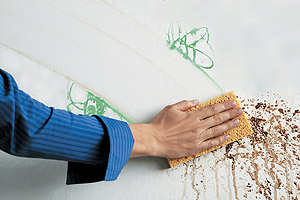 Duration Home, a high-quality interior paint from Sherwin-Williams with a washable matte finish, possesses many of the same qualities that ceramic-laden paint has, but it goes one better. Rather than having to use a mild cleanser to do the job, most stains can be washed away with just water. Photo courtesy of Sherwin-Williams Duration Home, a high-quality interior paint from Sherwin-Williams with a washable matte finish, possesses many of the same qualities that ceramic-laden paint has, but it goes one better. Rather than having to use a mild cleanser to do the job, most stains can be washed away with just water. Photo courtesy of Sherwin-Williams |
Ceramic Paints and
Ceramic Pigments
While some manufacturers tout the virtues of ceramic pigments, others are more skeptical. But all agree that it's the total formulation that creates a great paint.
by Stacey Enesey Klemenc
about their ceramic paint, you’re likely to hear a similar story. “The ceramic beads are a small part of what makes our product so different from the rest,” says Jeff Spillane, senior marketing manager for Benjamin Moore Paint. The secret to the superior performance of Benjamin Moore’s Regal Matte Finish, he says — as others will contend is true about their individual products — lies in the formulation.
Because when it comes to paint’s makeup, it’s no secret that the same three components have been used for centuries — namely water, resin and pigments. Titanium oxide, long revered for its whiteness, brightness and ability to give paint both hide and cover, is a pigment found in most quality paints today, including those that are labeled ceramic. “The ceramic increases durability and stain resistance,” Spillane says, but it’s not the sole pigment in any of the ceramic paints on the market. In many products, it’s not even the dominant pigment.
Shashi Patel, executive vice president for The Muralo Co., says his company’s current ceramic products are the result of combining Muralo’s superior waterborne technology with the top-notch ceramic technology of Graham Paint & Varnish Co., a company Muralo acquired in 2002. “The two together make a very different product,” he says. Whereas both companies had durable products that performed well on their own, merging the two technologies, he maintains, has created a new category with Muralo’s Ultra Ceramic and Graham’s Aqua Borne Ceramic lines.
Both Spillane and Patel uphold that their products are unlike other ceramic paints out there because their companies make their own resins. Both companies purchase their ceramic additives from an outside source. Muralo’s success, Patel stresses, lies mainly with its “very fine particle-size waterborne resin. This allows for more particle-to-particle contact, which in turn creates a product that has better binding and adhesion efficiency. Overall, it produces a stronger film.”
Spillane explains that Benjamin Moore developed the resin in Regal Matte expressly for the product, which was fully launched in 2004. Company literature refers to it as a “proprietary stain-release resin.”
No matter the spiel, both men agree about one thing. “Ceramic beads in a product are but a small part of what makes the product different,” Spillane says. “If you take a conventional latex paint and add ceramic beads to it, you don’t get a better product that will resist stains. The secret is all about building the product rather than just adding one ingredient.”
In its raw state, ceramic pigment is as fine as baby powder, Spillane says. “The ceramic spheres have to be very small to be dispersed in resin and to stay suspended in the product. If they were too big, they’d settle out.”
Patel explains that the ceramic pigments used in paint are shaped like tiny smooth spheres, unlike the irregular shape of more traditional pigments. These smooth, ball-like particles do two things for the paint:
- They make the coating easy to apply because it virtually “rolls” on without any drag from jagged edges, whether applied with a brush or roller, and
- They form a smooth surface that is long lasting, stain-resistant and washable without leaving a shiny telltale mark behind.
The most talked-about ceramic paint is the washable, flat enamel. But some companies, including Muralo, also make eggshell, flat, semigloss and high-gloss ceramic paint. |

